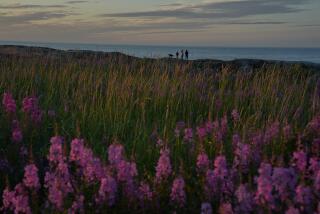Canada Debates Building Road to Arctic Coast : Northwest Territories: Link would open a huge area to development, which could threaten environment.
- Share via
YELLOWKNIFE, Northwest Territories — This vast, harsh territory covering one-third of Canada is Ottawa’s poor relation: isolated, underpopulated and living on federal handouts.
There are riches here--gold, diamonds, copper, lead, silver and zinc--but temperatures of minus 40 degrees or worse, 10 months of winter and dependence on air transport for moving goods make mining difficult and costly.
Nellie Cournoyea and her territorial government want to change all that by slashing a 550-mile road across the central Arctic from Yellowknife to the coast at Coronation Gulf. That would open a huge new area for development, but it also would raise environmental questions.
“There is a clear realization that jobs and the economy are priority No. 1 in the 1990s,” said John Todd, the territorial minister of nearly everything, including transportation, economic development and tourism.
The Northwest Territories has only 58,000 people, most of them Indians, in 1.3 million square miles. Unemployment is estimated at more than 16%, compared to 11.2% nationally. Half of the jobs that exist are in government and most of the budget comes from Ottawa, the federal capital.
One gold mine is operating in the region between Yellowknife and the sea, another is ready to resume production, a base metals project is on the verge of starting up and at least one diamond mine may open in the next few years. That could mean a bright future, and an all-weather road probably would attract more development.
“The advantage of a permanent road is that it could encourage other companies,” said George Patterson, the territory’s director of mineral policy. “But it’s only an option. It’s being studied because of the number of mines that could come into production.”
The price tag: $450 million, plus another $37.5 million for a port near Coppermine on the sea.
And a second price tag: The environmental cost of cutting a road that will be heavily traveled through a pristine wilderness called the Barrens, the home of the musk ox, caribou and grizzly bear. That cost remains unknown, environmentalists say, but some believe nature can accommodate development.
“There’s an all-weather road from Yellowknife clear to Edmonton, and if you go a kilometer off that road you are in the wilderness,” said David Livingstone, director of renewable resources and the environment for the federal Department of Indian Affairs and Northern Development.
“I agree that road access opens up a whole new scale of impacts, but I still think that, with careful management, we can have both.”
Still, there are real dangers for the great wilderness, most of it north of the tree line. It is a rocky tundra dotted with lakes, where polar bears, Arctic foxes, wolves and wolverines also roam.
“The road will change the face of that country,” said Steven Matthews, a wildlife biologist for the territorial Department of Renewable Resources. “The No. 1 issue is the grizzly, because . . . they require large tracts of undisturbed land.”
Other issues include the impact on migration of the Bathurst caribou herd, Canada’s largest, and the effect of icebreaking for the Coppermine port on inter-island migrations of Peary caribou.
Cournoyea is trying to sell the road project to Ottawa as a moneymaker.
“There is no doubt that opening access to the region will stimulate further exploration and development work,” she said in her pitch last year.
She estimated the net increase in the Canadian gross domestic product from new mines at $13.5 billion, new employment at more than 210,000 person-years, new income taxes at $1.2 billion and exports at $11.25 billion.
Above all, from her standpoint, much of that new money would remain in the north.
The Lupin gold mine 280 miles north of here regularly builds and maintains a winter road from Yellowknife at its own expense. This “ice road” across the frozen lakes and tundra is open about two months and is used to bring in a year’s worth of supplies. Other companies pay tonnage fees to use it.
Metall Mining Corp. is finishing a feasibility study for a base metals mine at Izok Lake, 210 miles from the coast. The company needs a road to Coppermine and a port.
Territorial officials fear that, if Metall Mining builds a road only from Izok Lake to the coast, all the benefits will be exported, leaving Yellowknife and the rest of the territory with nothing.
Noting that the the federal government’s reaction to Cournoyea’s road proposal has been cool, territorial legislator Michael Ballantyne said: “There is no spare change around anymore. It will probably have to be a combination of public and private participation.”
Once a road is built across the Barrens, people will use it--not only mining companies, but tourists, hunters and fishermen.
For some, that raises another fear.
“I don’t think they should build it,” said Jonas Sangris, chief of the Yellowknife Dene Band, one of many Indian groups struggling for self-government on traditional lands.
“There’s going to be too many people up there.”
More to Read
Sign up for Essential California
The most important California stories and recommendations in your inbox every morning.
You may occasionally receive promotional content from the Los Angeles Times.










